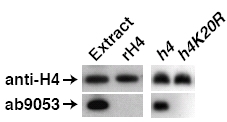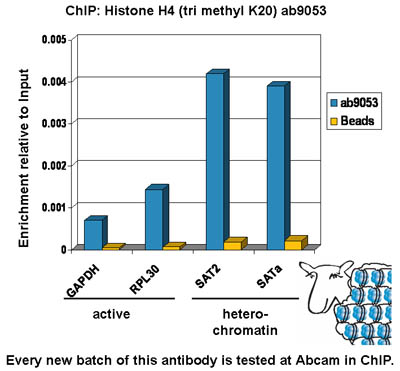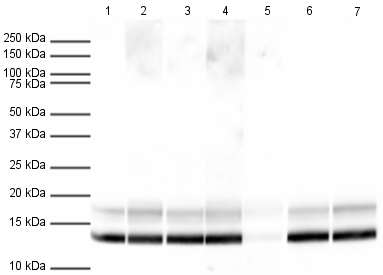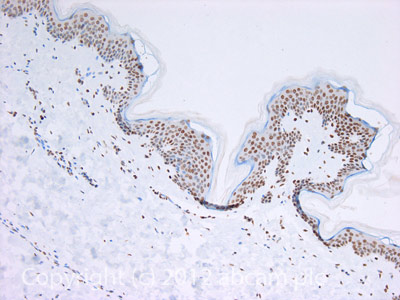Anti-Histone H4 (tri methyl K20) antibody - ChIP Grade
| Name | Anti-Histone H4 (tri methyl K20) antibody - ChIP Grade |
|---|---|
| Supplier | Abcam |
| Catalog | ab9053 |
| Prices | $403.00 |
| Sizes | 100 µg |
| Host | Rabbit |
| Clonality | Polyclonal |
| Isotype | IgG |
| Applications | ChIP ChIP IHC-P Electron microscopy IHC-P IHC-F ICC/IF ICC/IF FC WB ChIP |
| Species Reactivities | Mouse, Rat, Bovine, Human, S. pombe, Toxoplasma gondii, Mammalian |
| Antigen | Synthetic peptide conjugated to KLH derived from within residues 1 - 100 of Human Histone H4, tri methylated at K20 |
| Blocking Peptide | Human Histone H4 (tri methyl K20) peptide |
| Description | Rabbit Polyclonal |
| Gene | HIST4H4 |
| Conjugate | Unconjugated |
| Supplier Page | Shop |
Product images
Product References
Targeting and tracing of specific DNA sequences with dTALEs in living cells. - Targeting and tracing of specific DNA sequences with dTALEs in living cells.
Thanisch K, Schneider K, Morbitzer R, Solovei I, Lahaye T, Bultmann S, Leonhardt H. Nucleic Acids Res. 2014 Apr;42(6):e38.
Small RNA profiling of Xenopus embryos reveals novel miRNAs and a new class of - Small RNA profiling of Xenopus embryos reveals novel miRNAs and a new class of
Harding JL, Horswell S, Heliot C, Armisen J, Zimmerman LB, Luscombe NM, Miska EA, Hill CS. Genome Res. 2014 Jan;24(1):96-106.
Radiation-induced alterations of histone post-translational modification levels - Radiation-induced alterations of histone post-translational modification levels
Maroschik B, Gurtler A, Kramer A, Rossler U, Gomolka M, Hornhardt S, Mortl S, Friedl AA. Radiat Oncol. 2014 Jan 9;9:15.
Dynamics of the two heterochromatin types during imprinted X chromosome - Dynamics of the two heterochromatin types during imprinted X chromosome
Vaskova EA, Dementyeva EV, Shevchenko AI, Pavlova SV, Grigor'eva EV, Zhelezova AI, Vandeberg JL, Zakian SM. PLoS One. 2014 Feb 4;9(2):e88256.
Nucleosome acidic patch promotes RNF168- and RING1B/BMI1-dependent H2AX and H2A - Nucleosome acidic patch promotes RNF168- and RING1B/BMI1-dependent H2AX and H2A
Leung JW, Agarwal P, Canny MD, Gong F, Robison AD, Finkelstein IJ, Durocher D, Miller KM. PLoS Genet. 2014 Mar 6;10(3):e1004178.
A dual role for the histone methyltransferase PR-SET7/SETD8 and histone H4 lysine - A dual role for the histone methyltransferase PR-SET7/SETD8 and histone H4 lysine
Kapoor-Vazirani P, Vertino PM. J Biol Chem. 2014 Mar 14;289(11):7425-37.
Blimp-1 represses CD8 T cell expression of PD-1 using a feed-forward - Blimp-1 represses CD8 T cell expression of PD-1 using a feed-forward
Lu P, Youngblood BA, Austin JW, Mohammed AU, Butler R, Ahmed R, Boss JM. J Exp Med. 2014 Mar 10;211(3):515-27.
The maternal nucleolus plays a key role in centromere satellite maintenance - The maternal nucleolus plays a key role in centromere satellite maintenance
Fulka H, Langerova A. Development. 2014 Apr;141(8):1694-704.
Elucidating the molecular bases of epigenetic inheritance in non-model - Elucidating the molecular bases of epigenetic inheritance in non-model
Perfus-Barbeoch L, Castagnone-Sereno P, Reichelt M, Fneich S, Roquis D, Pratx L, Cosseau C, Grunau C, Abad P. Front Physiol. 2014 Jun 6;5:211.
Variant PRC1 complex-dependent H2A ubiquitylation drives PRC2 recruitment and - Variant PRC1 complex-dependent H2A ubiquitylation drives PRC2 recruitment and
Blackledge NP, Farcas AM, Kondo T, King HW, McGouran JF, Hanssen LL, Ito S, Cooper S, Kondo K, Koseki Y, Ishikura T, Long HK, Sheahan TW, Brockdorff N, Kessler BM, Koseki H, Klose RJ. Cell. 2014 Jun 5;157(6):1445-59.






